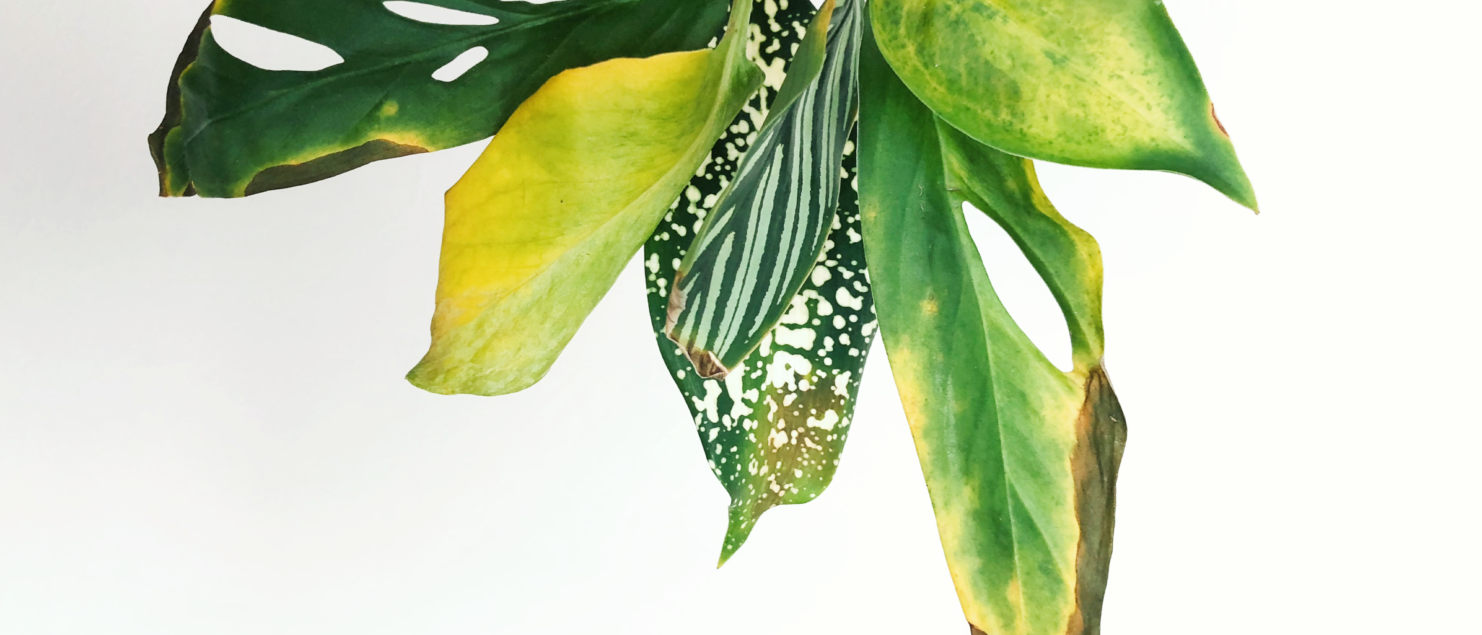Common Leaf Problems With Houseplants
Sometimes being a plant parent can feel like you have 99 problems and leaves are definitely one.
It doesn’t matter if you are a master of Horticulture or bought your first plant, there are many common houseplant problems that any plant parent will face. Houseplants can be tricky, and pretty trying at times. When it comes to houseplant problems it’s not a matter of if it will happen, but often times it’s when will it happen.
The most important thing to know is how to handle it when it happens.
Leaves can often be the first sign of a problem. Not only is it noticeable to the naked eye but also it’s usually where some common problems start off.
I’m going to go over the most common leaf problems – how to identify it and how to treat, so you can become a master houseplant mom or dad.
Brown Leaves /Tips:

Browning on leaves is caused by a few things. It maybe tricky to find exactly why these leaves are becoming brown, but with a little investigation on your plant, you’ll be able to find the cause.
Brown leaf tips can be caused by over or under watering. This is easy to identify by the soil moisture. If the soil feels pretty dry, its a good indication those leaves are browning from underwatering. Give your plant a good drink and keep an eye on your plant for the next few days to make sure no more leaves are turning brown. If the plant needs more water, try this first. If the problem persists, try upping the humidity around the plant.
Soil that is pretty wet can be a bigger problem. You may not only be dealing with brown leaves, but your plant may be telling you there’s a bigger issue – root rot. if you feel like it could be caused by rot or overwatering, I have a blog on root rot here.
Browning on leaves can also be caused by sunburn. Make sure you do your research on plant lighting requirements. If you suspect the plant is getting a little too much sun, even just moving the plant a few inches away from the direct sunlight will help tremendously.
I have also found that leaves can also start to brown up on certain plants with sensitive foliage, like Calatheas. Plants that have a more sensitive system, may need to be cared for a little different than the rest. These plants can get burns on their leaves if they are getting watered with tap water, or even filtered water. I have found that after watering my calathea’s with distilled water, helped their leaf tips from becoming brown.
Keep in mind that brown leaves won’t return to their old selves so, leaves that have turned brown need to be pruned and discarded. Once they are brown, they’re pretty much dead.
Yellowing Leaves:

If you start to see a few yellowing leaves here and there, that’s ok. It’s a normal process your plant will go through during the end of the year. It’s basically shedding off the old leaves.
It’s the circle of life
Yellowing leaves could also be from over or under watering. Make sure you check the soil moisture and water, if needed. If the plant is becoming over watered, you may want to check the roots and re-pot your plant. If you find any suspected rot, trim off the dead/infected roots, and repot in fresh sterile soil. Yellow leaves can like a big yellow sign for root rot.
Leaves that are yellowing could also be a sign of inefficient sunlight. If the soil isn’t an issue, move the plant closer to the light, either in grow lights or sun, but not in direct sunlight.
Pests can also cause yellowing on leaves, too. check both sides of the leaves and even the stems to see if you see any kind of critters, munching on your poor plant.
Make sure that if you see any yellowing leaves you remove them. By not removing yellow leaves the plant will try and put all its energy into that leaf, which can suck the plants energy for the rest of the plant. Yellow leaves are also pretty much goners and wont revent.
Curing leaves:

When you spot those taco shaped leaves, you know there’s something going on.
Curing leaves is the most common sign of over or under watering. Again, like most of the issues on here, under and over watering seem to be the biggest culprits. Checking the soil is the first step, and correcting the issue. Keeping an eye on your plant for the next few days to see if those leaves start to straighten out or not.
Fungal problems or diseases – even pests can be an issue as well, when it comes to curling leaves. Always make sure your examining you plants regularly for pest and make sure the root system looks normal.
Curling leaves often do correct themselves, so unlike the others on this list, keep the leaves attached – unless you start to see browning or yellowing, then snip snip.
Bye-Bye Foliage Foes

Leaves can be the first sign of a problem. Knowing the most common leaf problems, can make plant parenting easy, in a way. Over and under watering are the biggest culprits when it comes to any kind of plant related issue, or at least that’s the first thing I would check.
I’ve said it before and i’ll say it a thousand times, a moisture meter will be your best friend. Moisture meters completely take the guessing game out of watering. Which can leave you with a piece of mind and happy plants!
I hope this article explaining the most common leaf problems was helpful into finding out what going on with your leafy friend(s).
Let’s Get Social!
Instagram: @thebotanicalbrunette

